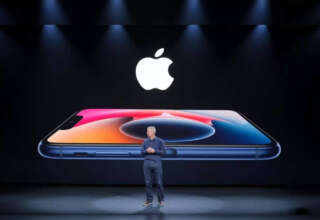
OPINION: If you’re still on social media you’ll have noticed this week’s new trend. The so-called 10 year challenge.
For those of you who haven’t come across this, the premise is simple enough. You post a picture of what you looked like 10 years ago, next to a picture of what you look like now. That’s it. And it’s absolutely everywhere.
The results are pretty predictable. Some people are slimmer. Others are bigger. Some look scarily similar.

Which is why I think it would be better if we posted pictures of the technology we were using 10-years ago instead.
READ MORE:
* Answering the impossible question: What’s the best laptop to buy?
* No mouse holds back the new iPad Pro
* We may have hit ‘peak phone’
* A guide to buying a 4K TV
There’s one small problem. Tech hardware has become a bit of a monopoly. The smartphone is the undisputed king.

The products we were using and spending hundreds of dollars on 10-year ago, like Sat Navs, Digital Cameras and iPods have all been wiped out by phones. Laptops are the only surviving technology.
That said, the smartphone and laptop 10-year challenge is still eye-opening. Was it really only 10-years ago I thought the products below were the best the industry had to offer?
Mobile Phone – Sony Ericsson W880i
It is 2009 and the original iPhone had been launched by now. It’s a year old, in fact. But it was still deemed inferior, by me and my pals, in the technology-reviewing industry. The better choice? This beauty. The Sony Ericsson W880i.
This phone, I thought, had it all. A 240×320 colour screen. 2MP rear-facing camera and 16MB of onboard storage, that you could expand to 1GB with a Sony memory stick. Woof.
That’s not all. The W880i demonstrated it was lightyears ahead of Apple, ditching the headphone jack way back in 2009.
The workaround was just as laughable as it is today, requiring not one, but two adapters to plug in a standard set of 3.5mm jack headphones.
The phone measured in at 9.4mm thick, which at the time, was important because it meant it was thinner than a CD case.
Less important back then was the ability to type anything longer than a 160 character SMS. Which perhaps explains this phone’s tiny buttons. And why I thought this was better than an iPhone.
Comparing this to the OnePlus 5T I am using today and the difference is scary.
The 1080 x 2160 optic AMOLED capacitive touchscreen display alone is good enough to represent 50 years of innovation, nevermind 10.
The progress the phone industry has made in a decade with its rear-facing cameras is equally impressive.
My OnePlus 5T boasts rear-facing 16MP and 20MP dual cameras capable of taking pin-sharp images. Looking back, the W880i’s 2MP camera, bless it, wasn’t fit for purpose.
And I’ve barely scratched the surface here.
Apps, Wi-Fi, GPS, NFC, Fingerprint Sensors, Face Recognition, 8GB RAM, 128GB Storage. This list goes on.
Thank god those dark days are over.
Laptop – Dell Inspiron 1545
Admittedly, I wasn’t breaking any records with my laptop choice in 2009.
The Dell Inspiron 1545 is, and was, about as middle-of-the-road laptop you can buy. It was a good allrounder with, importantly for me at the time, a DVD player built in.
I thought nothing of its hefty 2.6kg weight but was instead wooed by its 15.6-inch 1,366 x 768 HD display. I thought its sizeable 160GB HDD was what I needed too. Despite it taking a full two minutes to boot. On a good day. Whirling and groaning as it did so.
Today I am using Apple’s new MacBook Air. Comparing the two side-by-side is almost cruel. The 0.61-inch and 1.25kg MacBook is literally half the weight and size of the Inspiron.
Its 1.6GHz dual-core Intel Core i5 processor, 8GB RAM and 128GB SSD is also a total mismatch.
The biggest difference, however, is what the laptop industry has said goodbye to.
My Dell Inspiron 1545 proudly crowed about its specs. It featured a DVD Player, removable battery, Express Card slot, HDMI, S-Video output, VGA, Ethernet and 4x USB ports.
The new MacBook Air only has three holes. A 3.5mm headphone jack and two Thunderbolt 3 (USB‑C) ports.
A very different form of progress to the phone industry.
10-year challenge – Births and deaths
It’s been a brutal 10-years for some technologies.
DVD/Blu-ray players have been widely replaced by Netflix and other online streaming services. The compact digital camera has been swallowed by smartphones. As have Sat Navs. While Spotify has killed the iPod and other MP3 players. This list goes on.
And we’ve welcomed in some innovative new technologies too. Apple has sold 360 million iPads since debuting the technology back in 2010. Apple is also leading the way in the wearables industry with its hugely-advanced (in purely technology terms) Apple Watch. And just last week, Samsung debuted a range of health-care robots.
The next 10-years belongs to the Internet of Things. Connectivity is the future.
We’re still at the very early stages of the technology, with the likes of Google Home and Amazon Echo leading the way. Commands such as “Google, what’s the weather like today?” and “Alexa, play me some music” are impressive. But they’re just the beginning.
“Google, clean my house” or “Alexa, make my breakfast” is where we’re heading.
Which is a good thing, right?
[“source=stuff.co.nz”]






